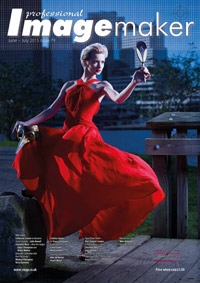articles/Lighting/light-part37-page2
Creating With Light - Part 37 - Hypersync - part 2 of 1 2 3 4
by Dave Montizambert Published 01/06/2015

As I said above, the open-sky is lighting the front of Kelsey and read f4.0 at 1⁄160th, this will expose at 32⁄3 stops under the camera setting of f4 at 1⁄1,600th, in other words the open sky will deliver low-level fill lighting to Kelsey's front while the direct sunlight will appear very bright on the back edges of Kelsey's body, dress, and hair. See Image 002B to see the image shot at f4 1⁄1,600th; note how the backlighting on the dress and Kelsey is perfect, adding extra depth to the image, but the front of Kelsey is 32⁄3 stops underexposed and is lit with boring flat light. Here's where the mixed light part comes in, to create more suitable lighting and exposure on the front of the subject, a Small Chimera soft-box (0.6 x 1.0 metre) attached to an X3200 WhiteLightning mono block studio strobe plugged into a portable Pro-Foto battery pack was placed 2.5 metres from Kelsey on the camera-right side. The strobe is triggered with a Pocket Wizard Plus III on the light and a Pocket Wizard Flex TT5 on the camera. One of the cool bits of working with Pocket Wizards and Sekonic meters together is, I can set the meter so that every time I press the take-a-reading button, it sends a signal to the Pocket Wizard receiver to fire the light, isn't that just the greatest thing since chocolate truffles? How often do photo-gear manufacturers cooperate like this? Placing this light to the side of Kelsey makes for light that skims the front of the dress, creating lots of texture and beautiful dramatic highcontrast shadows that are slightly filled in by the open sky, see Image 002C and 001.
There is, however, one thing wrong with this set-up, because I'm shooting at 1⁄1,600th, the camera shutter is unable to sync with the strobe flash at this shutter-speed, the fastest it can handle is no more than 1⁄200th-of-a-second.
Not a problem because the Pocket Wizard Flex TT5 which happens to be programmable. I can actually set it to create an offset that causes the camera to only collect the end portion of the strobe burst, this gradual trailing off portion of the burst occurs right after the strobe peaks. You are of course losing a lot of the strobe power by omitting the peak, but since we're shooting with a fairly powerful strobe and with our camera aperture wide open, we get more than enough light. So the imaging sensor receives mostly constant light during the travel of the opening shutter-blades rather than an intense short light-spike for a fraction of the exposure. To figure out what offset to program the Flex TT5 to, I refer to my previously shot Hypersync test results chart, find the offset that corresponds with the shutter speed I'm wanting to shoot at, then set this offset figure on the Flex TT5 (all this info and how to do the test in an upcoming article). For this to work though, we must run the strobe at full power. Based on my test chart I need to make the strobe light read f16 incident at the subject if I want to expose correctly at my f4 camera setting. That sounds a little nutty, but remember that the meter can only collect and read the full burst of light from the strobe, whereas our camera-shutter, which is being manipulated by the Pocket Wizard, is only going to collect strobe-light after the peak - this after-peak light is the end portion of the burst which is considerably more constant in brightness than the peak, it is however, also much-less bright.
Please Note:
There is more than one page for this Article.
You are currently on page 2
- Creating With Light - Part 37 - Hypersync page 1
- Creating With Light - Part 37 - Hypersync page 2
- Creating With Light - Part 37 - Hypersync page 3
- Creating With Light - Part 37 - Hypersync page 4
1st Published 01/06/2015
last update 09/12/2022 14:55:57
More Lighting Articles
There are 16 days to get ready for The Society of Photographers Convention and Trade Show at The Novotel London West, Hammersmith ...
which starts on Wednesday 14th January 2026





